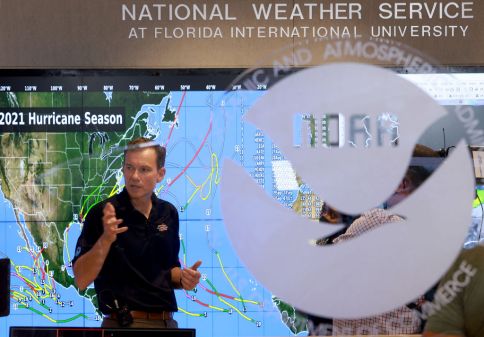NASA looks to spur development of commercial satellite services it can use

NASA hopes six satellite communications demonstrations will spur the development of commercial services it can use to quickly transmit large volumes of data from space.
The agency’s Communications Services Project (CSP) awarded Space Act agreements sharing cost and risk to six satellite communications (SATCOM) companies — Amazon’s Kuiper Systems, Inmarsat, SES, SpaceX, Telesat, and Viasat — in April, and now they will spend the next four years preparing for and presenting demos of their capabilities.
The Space Act, which was passed in 1958, enables NASA to partner with companies that advance its mission through commercial contracts that fall outside the authority of the Federal Acquisition Regulation.
NASA’s Tracking and Data Relay Satellite (TDRS) constellation of geostationary (GEO) satellites was developed in the 1980s for near-Earth communications with space shuttles in particular. But those capabilities will diminish significantly by the early 2030s, and NASA wants to replace them with advanced commercial services to save money.
“The idea is to free ourselves of the infrastructure that we have to sustain and those costs and really just buy it as a commercial service,” Eli Naffah, CSP manager at the NASA Glenn Research Center, told FedScoop. “What that will do is free up valuable resources for NASA to really focus on what we need to do, and that’s exploration and science.”
Low-Earth orbit (LEO) observation satellites used by some of NASA’s science missions currently take minutes to hours to transmit data.
Viasat’s ViaSat-3 constellation of three GEO, Ka-band satellites launches this year and next and will deliver the same communications the company provides to thousands of aircraft to LEO satellites. TDRS lacks a cross-linking capability that ViaSat-3 will have between GEO relays, and Viasat expects its satellites will deliver 1 terabyte of data per second.
The company boasts it could provide Netflix to the International Space Station and broadband capabilities to hundreds or thousands of NASA assets.
“If you think about bringing a much more scalable system to bear here, you’re going to have a lot more capability and the ability to measure the Earth’s atmosphere, to measure the oceans, to understand climate change a little better and a lot of these other Earth-sensing missions,” said Craig Miller, president of Viasat Government Systems.
Streaming data off thousands of satellites simultaneously in real time would be “transformational” for NASA, and all it would take is a plug-and-play Viasat modem on each asset, Miller said.
The service could also be used by NASA’s Artemis program, a series of voyages to ultimately land astronauts on Mars, so its systems have real-time connectivity when they’re close to Earth.
Viasat expects to demonstrate its service for NASA in 2024 or 2025, when it officially launches, providing worldwide coverage along almost any orbit including over the poles to users.
Some demos may stretch into 2026 with NASA conducting acquisition planning, which has already begun, in tandem.
CSP gave the six companies it selected for demos broad goals like delivering data and files at faster speeds and continuous coverage to avoid unacceptable loss of service during human spaceflights.
The project will evaluate Viasat, for instance, using LEO-based platforms simulating NASA missions.
Commercial capabilities that pass muster will be onboarded and certified for NASA missions in 2027 for deployment as TDRS capabilities are phased out.
Industry, with its terrestrial customers, significantly outpaces NASA’s investments in SATCOM and GEO satellites in particular. The six companies that signed Space Act agreements with NASA are taking on more than $1.5 billion of the demonstrations’ cost, compared to the agency’s $278 million.
“Industry came back with significant cost share, which allowed us to award six,” Naffah said.


